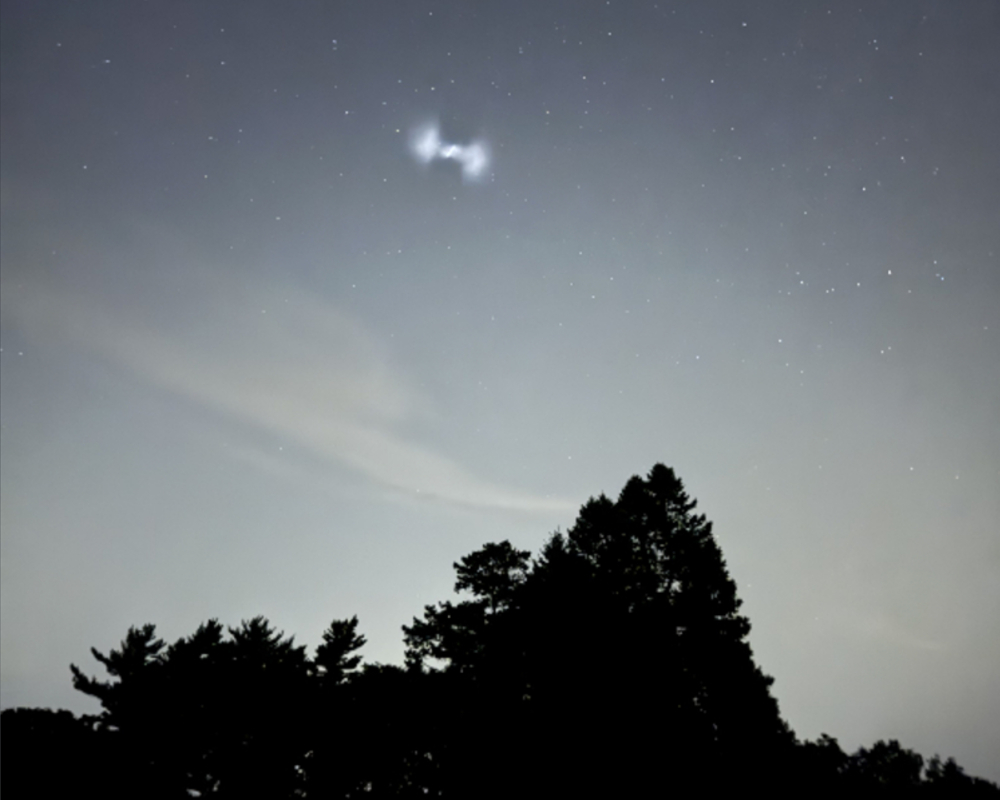Ghostly 'spiral' photobombs Perseid meteors over several US states — and experts are unsure what caused it
The ghostly light, which was triggered by a rocket reentry, sailed across the night sky as skywatchers across the U.S. looked up to see "shooting stars" streak across the heavens. However, experts are confused over which spacecraft is responsible.

While searching for "shooting stars" from the Perseid meteor shower, stargazers across large parts of the U.S. were recently treated to a stunning surprise: a giant spiral of ghostly white light. And while we know what phenomenon they saw, experts are not 100% sure of its exact oirgin.
At around 10:30 p.m. ET Tuesday (Aug. 12), right as the Perseid meteor shower started to peak, a faint point of light emerged in the skies over parts of the U.S. and Canada, before quickly growing and unfurling itself into a giant, luminous whirlpool. It then sailed across the sky for around 10 minutes, before dissipating into nothingness. It was spotted in at least 10 states, including Maryland, New York, New Jersey, Illinois, Ohio and Nebraska.
Photographer Joshua Thum captured a shot of the ethereal spectacle over Yerkes Observatory in Williams Bay, Wisconsin (see above), while astrophotographer Dan Bush recorded stunning footage of the spiral moving across the night sky in Albany, Missouri (see below).
The spiral consisted of rocket fuel that had been dumped from a spacecraft preparing to reenter Earth's atmosphere. In this type of maneuver, the fuel freezes into a cloud of tiny crystals that reflect sunlight onto the planet's surface, making it shine in the night sky until the crystals dissipate and become invisible to the naked eye. What's left of the rocket is normally spinning by the time the fuel is released, which is what causes the resulting cloud of crystals to form a spiral shape.
Related: 10 bizarre phenomena that lit up the sky (and their scientific explanations)
Initial reports suggested that the spiral was triggered by a United Launch Alliance Vulcan Centaur rocket that launched from Cape Canaveral, Florida, at 8:56 p.m. ET Tuesday and released two military satellites into orbit, according to Spaceweather.com.
However, it was later revealed that one of the European Space Agency's Ariane 6 rockets had been launched from a spaceport in French Guiana only 19 minutes earlier, before eventually releasing a European weather satellite into orbit around our planet. This led to confusion about which rocket triggered the spiral.
Get the world’s most fascinating discoveries delivered straight to your inbox.
"There's a lot of debate about this one as to where it came from and what we were witnessing as far as the geometry of what was going on, so I'm not making any guesses as to what it was," Bush told Spaceweather.com.
Jonathan McDowell, an astronomer at the Harvard & Smithsonian Center for Astrophysics who has been tracking rocket launches for more than three decades, told ABC News that he believes the Ariane 6 rocket is the most likely candidate, based on its trajectory. However, it is still not entirely clear which rocket triggered the spiral.
Glowing spirals and similar light shows have become more common in recent years as the number of rocket launches has increased sharply, thanks largely to the emergence of private companies like SpaceX.
Most of these glowing structures have been triggered by SpaceX's Falcon 9 rockets and thus have been dubbed "Space X spirals." One of the most recent examples was a gigantic whirlpool that shone above the U.K. and parts of Europe in March.
Other striking SpaceX spirals include a super-rare "horned" spiral that emerged over Europe in May 2024; a large, white whirlpool that appeared over the Arctic in March 2024; and a striking blue structure that glowed alongside auroras in April 2023. The phenomenon was also spotted by the Subaru Telescope in Hawaii in April 2022 and again in January 2023.

Harry is a U.K.-based senior staff writer at Live Science. He studied marine biology at the University of Exeter before training to become a journalist. He covers a wide range of topics including space exploration, planetary science, space weather, climate change, animal behavior and paleontology. His recent work on the solar maximum won "best space submission" at the 2024 Aerospace Media Awards and was shortlisted in the "top scoop" category at the NCTJ Awards for Excellence in 2023. He also writes Live Science's weekly Earth from space series.
You must confirm your public display name before commenting
Please logout and then login again, you will then be prompted to enter your display name.



